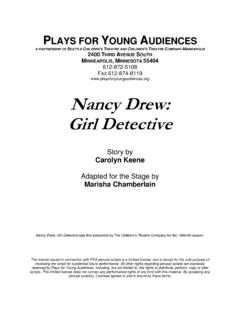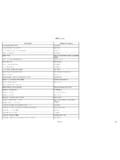Transcription of Audio Transformers
1 Audio TransformersbyBill WhitlockJensen Transformers , Deering AvenueChatsworth, CA 91311 This work first published by Focal Press in 2001 asChapter 11 Handbook for Sound Engineers, Third EditionGlen Ballou, EditorCopyright 2001, 2006 Bill WhitlockAll rights reservedBill WhitlockAudio TransformersPage 1 Handbook for Sound Engineers, 3 Editionrd 1 Audio Transformer Principles and Fields and and Turns of Practical Materials and Resistances and Inductance and Winding Capacitances and Faraday Application Signal Level, Distortion, and Source with Zero Reflection of Noise Classification by Transformers for Specific Coil Phono and Power Isolation or Splitter.
2 Impedance to Microphone Input or Direct Box .. Isolation or Hum Eliminators .. Distribution or Constant Voltage .. Isolation or Repeat Coil .. Directional Coupling or Hybrid .. Coil Phono and Data and , Capacitances, and Other to Impress or to Inform?.. Data Sheet Installation and Few Installation WhitlockAudio TransformersPage 2 Handbook for Sound Engineers, 3 EditionrdFigure 1 - Magnetic FieldSurrounding ConductorFigure 4 - Inductive CouplingFigure 3 - CoilConcentrates FluxFigure 2 - AC Magnetic Field1 Audio Transformer BasicsSince the birth of Audio electronics, the Audio transformer has played an important role.
3 When compared to modern miniaturizedelectronics, a transformer seems large, heavy, and expensive but it continues to be the most effective solution in many audioapplications. The usefulness of a transformer lies in the fact that electrical energy can be transferred from one circuit to anotherwithout direct connection, and in the process the energy can be readily changed from one voltage level to another. Although atransformer is not a complex device, considerable explanation is required to properly understand how it operates. This chapter isintended to help the Audio system engineer properly select and apply Transformers .
4 In the interest of simplicity, only basic conceptsof their design and manufacture will be Principles and Fields and InductionAs shown in Figure 1, a magnetic field is created around anyconductor (wire) in which current flows. The strength of thefield is directly proportional to current. These invisible magneticlines of force, collectively called flux, are set up at right anglesto the wire and have a direction, or magnetic polarity, whichdepends on the direction of current flow. Note that although theflux around the upper and lower wires have different directions,the lines inside the loop aid because they point in the samedirection.
5 If an alternating current flows in the loop, theinstantaneous intensity and polarity of the flux will vary at thesame frequency and in direct proportion to the instantaneouscurrent. We can visualize this flux, represented by the concentric circles in Figure 2, as expanding,contracting, and reversing in polarity with each cycle of the ac current. The law of induction statesthat a voltage will be induced in a conductor exposed to changing fluxand that the induced voltage will be proportional to the rate of the fluxchange. This voltage has an instantaneous polarity which opposes theoriginal current flow in the wire, creating an apparent resistance called inductive reactance.
6 InductiveLLreactance is calculated according to the formula X = 2 fL, where X is inductive reactance in ohms, fis frequency in Hz, and L is inductance in Henries. An inductor generally consists of many turns orloops of wire called a coil, as shown in Figure 3, which links and concentrates magnetic flux lines,increasing the flux density. The inductance of any given coil is determined by factors such as thenumber of turns, the physical dimensions and nature of the winding, and the properties of materials inthe path of the magnetic to the law of induction, a voltage will be induced in any conductor (wire) that cutsflux lines.
7 Therefore, if we place two coils near each other as shown in Figure 4, an accurrent in one coil will induce an ac voltage in the second coil. This is the essential principleof energy transfer in a transformer. Because they require a changing magnetic field tooperate, Transformers will not work at dc. In an ideal transformer, the magnetic couplingbetween the two coils is total and complete, , all the flux lines from one cut across all theturns of the other. The coupling coefficient is said to be unity or and Turns RatioThe coil or winding that is driven by an electrical source is called the primary and the other is called the secondary.
8 The ratio ofthe number of turns on the primary to the number of turns on the secondary is called the turns ratio. Since essentially the samevoltage is induced in each turn of each winding, the primary to secondary voltage ratio is the same as the turns ratio. For example,with 100 turns on the primary and 50 turns on the secondary, the turns ratio is 2:1. Therefore, if 20 volts were applied to theprimary, 10 volts would appear at the secondary. Since it reduces voltage, this transformer would be called a step-downtransformer. Conversely, a transformer with a turns ratio of 1:2 would be called a step-up transformer since its secondary voltagewould be twice that of the primary.
9 Since a transformer does not create power, the power output from the secondary of an idealtransformer can only equal (and in a real transformer only be less than) the power input to the primary. Consider an ideal 1:2 step-up transformer. When 10 volts is applied to its primary, 20 volts appears at its secondary. Since no current is drawn by theBill WhitlockAudio TransformersPage 3 Handbook for Sound Engineers, 3 EditionrdFigure 5 - Excitation CurrentFigure 6 - Cancellation of FluxGenerated by Load CurrentFigure 7 - Excitation Current and FluxVary Inversely with Frequencyprimary, its impedance appears to be infinite or an open circuit.
10 When a 20 load is connected to the secondary, a current of 1amp flows making output power equal 20 watts. At the same time, a current of 2 amps is drawn by the primary, making inputpower equal 20 watts. Since the primary is now drawing 2 amps with 10 volts applied, its impedance appears to be 5 . In otherwords, the 20 load impedance on the secondary has been reflected to the primary as 5 . In this example, a transformer with a1:2 turns ratio exhibited an impedance ratio of 1:4. Transformers always reflect impedances from one winding to another by thesquare of the their turns ratio or, expressed as a formula: Zp/Zs = (Np/Ns) where Zp is primary impedance, Zs is secondary2impedance, and Np/Ns is turns ratio (which is the same as the voltage ratio).





